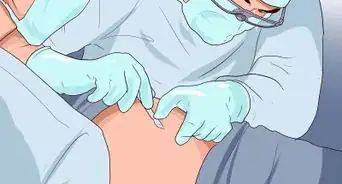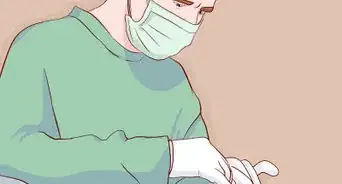This article was co-authored by Dale Prokupek, MD. Dale Prokupek, MD is a board-certified Internist and Gastroenterologist who runs a private practice based in Los Angeles, California. Dr. Prokupek is also a staff physician at Cedars-Sinai Medical Center and an associate clinical professor of medicine at the Geffen School of Medicine at the University of California, Los Angeles (UCLA). Dr. Prokupek has over 30 years of medical experience and specializes in the diagnosis and treatment of diseases of the liver, stomach, and colon, including chronic hepatitis C, colon cancer, hemorrhoids, anal condyloma, and digestive diseases related to chronic immune deficiency. He holds a BS in Zoology from the University of Wisconsin – Madison and an MD from the Medical College of Wisconsin. He completed an internal medicine residency at Cedars-Sinai Medical Center and a gastroenterology fellowship at the UCLA Geffen School of Medicine.
There are 9 references cited in this article, which can be found at the bottom of the page.
This article has been viewed 2,074,350 times.
Colors of poop can indicate a number of illnesses, suggesting specific, possible problems that may need attention. Stop being puzzled by amorphous colors of bowel movements. By learning how to scan the specific color indicators, you can read the poop colors and might avoid minor issues. You can also learn when you should see your doctor about issues with your digestion.
Steps
Learning What Different Stool Colors May Indicate
-
1Check for red or black stools. These could both potentially be a sign of something going wrong in your digestive system. Both black and bright red stool could be an indicator of bleeding somewhere in the intestines, or from something more minor like hemorrhoids.[1]
- Bleeding from the small intestines usually produces melena, or black, tarry stools. Bleeding that originates in lower gastrointestinal tract (such as bleeding from hemorrhoids) usually results in bright red blood.
- There are other minor factors like diet and medications that could color stools black and red, but if you are concerned, it’s always best to talk to your healthcare provider.
-
2Look out for white, gray, or light-colored stool. Bile contributes to the coloring of stool, so this lack of color could actually indicate the absence of bile. This could mean there’s something blocking a bile duct, which could potentially be an indicator for a serious medical problem. If you ever notice white or light colored stools, make sure you talk to your doctor right away.[2]
- White stools usually result from steatorrhea (excretions of fat) which can may indicate pancreatic issues.
Advertisement -
3Remember that brown poop is the most normal. While stool colors can range from browns to yellows to greens and still be considered “normal” and healthy, a medium brown color is the most common in healthy stool. It should be about the same color as a chocolate bar.[3]
- Stool turns brown through a complicated process in the digestive tract. Basically, the color comes from the protein hemoglobin being broken down to create bilirubin in the liver.
-
4Remember that certain foods can cause a change in stool color. Food coloring, leafy vegetables, and even beets can tint stool different colors. This is normal. For example, eating leafy green veggies like kale or spinach could give your stool a green color, and eating beets could potentially turn stool a reddish color. This shouldn’t be cause for alarm, especially if you’ve recently eaten these foods.[4]
- Only rarely is red stool a serious indicator of an issue in the intestine. Even bright red stool could simply be caused by bleeding from minor and common conditions like hemorrhoids.
-
5Remember that foods high in fat can sometimes cause yellow stool. If you notice your stool is yellow in color (steatorrhea), this could be a sign of a lack of fat absorption in your digestive track. There are many things that could cause problems with absorbing fats, so if this yellow stool persists for more than two days, give your doctor a call.[5]
- Yellow stool that is also especially smelly or greasy could also be a sign of a problem with or allergy to gluten. Your doctor can confirm whether or not this is the cause.[6]
-
6Consider what medications you’re taking. Many medications, from vitamin supplements to anti-diarrheal medications to prescription medications, can cause changes in stool color. These color changes are normal when associated with the use of those medications, so make sure to read the warning or side effects label on anything you take on a regular basis.[7]
- Iron supplements could potentially turn your stool green or black, while bismuth subsalicylate (the anti-diarrheal found in Pepto Bismol) can also turn stool black.
-
7Keep in mind that newborns often have black, tarry stools. In the first few days after birth, it’s completely normal for some black stool to show up in your baby’s diaper. This will pass within 2-4 days, after the baby has gotten all of the meconium out of its body. It will likely transition into an earthy green color after that, and it will stay a mushy consistency.[8]
- Your baby’s poop while breastfeeding will likely be mushy, and either a green or yellow color. This is normal.
- Formula-fed babies will probably have mushy stool that is more brown than babies that are breastfed, but this is perfectly normal as well.
Understanding When to See a Doctor
-
1Seek medical attention for bright red or black stool. Even though these colorations could be caused by dietary changes or medications, these colors could also be indicators of blood in the intestinal tract. If you have blood in your stool, or are actively bleeding when you have a bowel movement, seek medical attention as soon as possible.[9]
- If your stool is bright red or black and you recently ingested anti-diarrheal medications, food with red dye in it, or started a new medication, make an appointment with your doctor to make sure the change in your stool color isn’t indicating anything more serious. Your doctor will run various tests on your stool like a fecal occult blood test to determine the cause.
-
2Understand the rarity of a stool color indicating a very serious medical condition. Most of the time, changes in stool color can be explained by treatable conditions, or simply by dietary causes. It’s unlikely that a change in your stool color is cause for a trip to the emergency room, or even for any panic.[10]
- Always check for recent changes in your diet or side effects of medications if your stool color changes suddenly.
-
3See a doctor if you are concerned. Regardless of the cause, if you are concerned about your stool or changes in your digestion, your safest and most effective method of treatment should be to seek advice from your doctor. A doctor will be able to identify for certain if there is anything to worry about, or if what you’re dealing with is normal.[11]
- Even if it might feel embarrassing or make you feel anxious to talk about your bowel movements, it’s important to bring them up with your doctor if you are concerned. It’s always better to play it safe and get a medical opinion.
-
4Consider what other physical symptoms are associated with your change in stool color. If the change in color is associated with abdominal pain or sudden diarrhea, for example, it could be a sign of something more than just a dietary change. If your stool color change is associated with any other sudden symptoms, see your doctor.
- Black or red diarrhea, for example, could be a sign of a serious condition and should be addressed immediately.[12]
Maintaining Healthy Digestion
-
1Stay hydrated. By keeping yourself well hydrated, you can help the process of digestion happen smoothly and easily. Water can help soften stool and help you avoid issues like constipation. It can also help you absorb certain nutrients more efficiently from the food you take in.
- Try keeping a water bottle with you at all times. Refill it whenever you finish it, and try to drink around 1 to 2 liters (0.3 to 0.5 US gal) of fluids every day.[13]
-
2Maintain a healthy diet. A healthy diet isn’t just defined by what you eat, but also by how often and how quickly you eat it. In order to make sure your digestion takes place as smoothly as possible, try to eat slowly. Don’t rush and eat too quickly. This can potentially cause stomach upset. Try to eat smaller meals throughout the day rather than overeating in one sitting.
- Naturally, what you eat does matter! Try foods with high fiber content, like fruits and vegetables. Try to make half of your plate vegetables at every meal. Also, try your best to lower or limit your intake of things like processed foods, and alcohol.
-
3Exercise regularly. Maintaining a regular exercise routine can promote overall health. In terms of your digestive health specifically, exercise can actually help strengthen the muscles in your abdomen and trigger the digestive process. Try fitting in a brisk walk or light jog at least a few times a week.[14]
- You can also fit exercise into your everyday routine by taking simple steps such as taking the stairs instead of the elevator, or picking the far parking spot rather than the one right by the door.
- Try to get at least 30 minutes of moderate-intensity exercise five days a week, or 150 minutes total.
-
4Watch your stress levels. Stress can wreak havoc on your body, and really do a number on your digestive process. Stress can cause constipation, diarrhea, abdominal pain, and even loss of appetite. If you have high stress levels, try to find a de-stressing method that works for you, like daily meditation, or eliminating unnecessary triggers of stress.[15]
Expert Q&A
Did you know you can get expert answers for this article?
Unlock expert answers by supporting wikiHow
-
QuestionWhat color might your stool be if you have cancer?
 Dale Prokupek, MDDale Prokupek, MD is a board-certified Internist and Gastroenterologist who runs a private practice based in Los Angeles, California. Dr. Prokupek is also a staff physician at Cedars-Sinai Medical Center and an associate clinical professor of medicine at the Geffen School of Medicine at the University of California, Los Angeles (UCLA). Dr. Prokupek has over 30 years of medical experience and specializes in the diagnosis and treatment of diseases of the liver, stomach, and colon, including chronic hepatitis C, colon cancer, hemorrhoids, anal condyloma, and digestive diseases related to chronic immune deficiency. He holds a BS in Zoology from the University of Wisconsin – Madison and an MD from the Medical College of Wisconsin. He completed an internal medicine residency at Cedars-Sinai Medical Center and a gastroenterology fellowship at the UCLA Geffen School of Medicine.
Dale Prokupek, MDDale Prokupek, MD is a board-certified Internist and Gastroenterologist who runs a private practice based in Los Angeles, California. Dr. Prokupek is also a staff physician at Cedars-Sinai Medical Center and an associate clinical professor of medicine at the Geffen School of Medicine at the University of California, Los Angeles (UCLA). Dr. Prokupek has over 30 years of medical experience and specializes in the diagnosis and treatment of diseases of the liver, stomach, and colon, including chronic hepatitis C, colon cancer, hemorrhoids, anal condyloma, and digestive diseases related to chronic immune deficiency. He holds a BS in Zoology from the University of Wisconsin – Madison and an MD from the Medical College of Wisconsin. He completed an internal medicine residency at Cedars-Sinai Medical Center and a gastroenterology fellowship at the UCLA Geffen School of Medicine.
Board Certified Internist & Gastroenterologist
-
QuestionIs black and brown a normal poop color?
 Chris M. Matsko, MDDr. Chris M. Matsko is a retired physician based in Pittsburgh, Pennsylvania. With over 25 years of medical research experience, Dr. Matsko was awarded the Pittsburgh Cornell University Leadership Award for Excellence. He holds a BS in Nutritional Science from Cornell University and an MD from the Temple University School of Medicine in 2007. Dr. Matsko earned a Research Writing Certification from the American Medical Writers Association (AMWA) in 2016 and a Medical Writing & Editing Certification from the University of Chicago in 2017.
Chris M. Matsko, MDDr. Chris M. Matsko is a retired physician based in Pittsburgh, Pennsylvania. With over 25 years of medical research experience, Dr. Matsko was awarded the Pittsburgh Cornell University Leadership Award for Excellence. He holds a BS in Nutritional Science from Cornell University and an MD from the Temple University School of Medicine in 2007. Dr. Matsko earned a Research Writing Certification from the American Medical Writers Association (AMWA) in 2016 and a Medical Writing & Editing Certification from the University of Chicago in 2017.
Family Medicine Physician
-
QuestionWhy do I have blood in my stool?
 Chris M. Matsko, MDDr. Chris M. Matsko is a retired physician based in Pittsburgh, Pennsylvania. With over 25 years of medical research experience, Dr. Matsko was awarded the Pittsburgh Cornell University Leadership Award for Excellence. He holds a BS in Nutritional Science from Cornell University and an MD from the Temple University School of Medicine in 2007. Dr. Matsko earned a Research Writing Certification from the American Medical Writers Association (AMWA) in 2016 and a Medical Writing & Editing Certification from the University of Chicago in 2017.
Chris M. Matsko, MDDr. Chris M. Matsko is a retired physician based in Pittsburgh, Pennsylvania. With over 25 years of medical research experience, Dr. Matsko was awarded the Pittsburgh Cornell University Leadership Award for Excellence. He holds a BS in Nutritional Science from Cornell University and an MD from the Temple University School of Medicine in 2007. Dr. Matsko earned a Research Writing Certification from the American Medical Writers Association (AMWA) in 2016 and a Medical Writing & Editing Certification from the University of Chicago in 2017.
Family Medicine Physician You have blood in your stool if there is a bleed in the GI tract. This can be from a gastric ulcer due to using too many NSAIDs (nonsteroidal anti-inflammatory drugs), or can be from something simple like hemorrhoids. One caution to note if you are inexplicably losing weight and have anemia or blood in your stool, you may need a colonoscopy to rule out cancer.
You have blood in your stool if there is a bleed in the GI tract. This can be from a gastric ulcer due to using too many NSAIDs (nonsteroidal anti-inflammatory drugs), or can be from something simple like hemorrhoids. One caution to note if you are inexplicably losing weight and have anemia or blood in your stool, you may need a colonoscopy to rule out cancer.
Warnings
- See a doctor for medical advice if you’re concerned about your stool colors.⧼thumbs_response⧽
References
- ↑ Dale Prokupek, MD. Board Certified Internist & Gastroenterologist. Expert Interview. 16 April 2020.
- ↑ http://www.mayoclinic.org/white-stool/expert-answers/faq-20058216
- ↑ https://www.unitypoint.org/livewell/article.aspx?id=d7a92af5-f39d-46fa-81ef-a17dce49788f
- ↑ http://www.hopkinsmedicine.org/johns-hopkins-childrens-center/what-we-treat/specialties/gastroenterology-nutrition/stool-color-overview.html
- ↑ https://www.unitypoint.org/livewell/article.aspx?id=d7a92af5-f39d-46fa-81ef-a17dce49788f
- ↑ http://www.mayoclinic.org/stool-color/expert-answers/faq-20058080
- ↑ http://www.mayoclinic.org/stool-color/expert-answers/faq-20058080
- ↑ http://www.babycenter.com/0_baby-poop-a-complete-guide_10319333.bc
- ↑ Dale Prokupek, MD. Board Certified Internist & Gastroenterologist. Expert Interview. 16 April 2020.
- ↑ http://www.mayoclinic.org/stool-color/expert-answers/faq-20058080
- ↑ https://www.unitypoint.org/livewell/article.aspx?id=d7a92af5-f39d-46fa-81ef-a17dce49788f
- ↑ http://www.emedicinehealth.com/diarrhea/page3_em.htm#when_to_seek_medical_care_for_diarrhea
- ↑ http://www.mayoclinic.org/healthy-lifestyle/nutrition-and-healthy-eating/in-depth/water/art-20044256
- ↑ Dale Prokupek, MD. Board Certified Internist & Gastroenterologist. Expert Interview. 16 April 2020.
- ↑ https://consumer.healthday.com/encyclopedia/digestive-health-14/digestion-health-news-200/stress-and-the-digestive-system-645906.html
About This Article
Checking the color of your stool is an easy way to identify common health problems with your digestive system. If your stool is red or black, this can be a sign of blood in your intestines or another part of your digestive system. Since this is a serious medical issue, you should see a doctor as soon as possible. Look out for white or gray stool, since this may indicate a lack of bile, which can be a serious medical problem. Remember that your stool can change color after you’ve eaten something, like green leafy vegetables or red beets, so it shouldn't always be a cause for panic. If you’re unsure whether the change in color is being caused by something more serious, consider whether you’re having other symptoms, like abdominal pain or diarrhea. For tips from our Medical co-author on how to maintain a healthy digestive system, keep reading!











































































Medical Disclaimer
The content of this article is not intended to be a substitute for professional medical advice, examination, diagnosis, or treatment. You should always contact your doctor or other qualified healthcare professional before starting, changing, or stopping any kind of health treatment.
Read More...